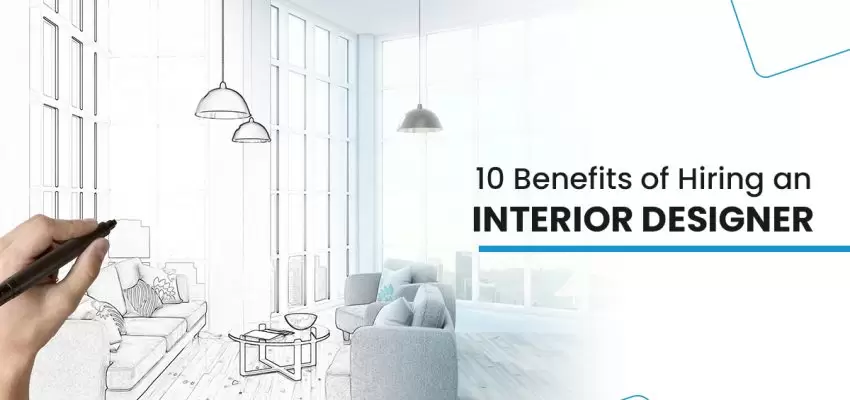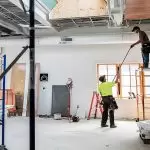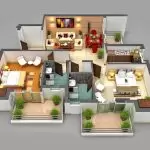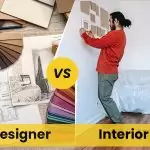You would be seeking to heighten the aesthetics and functionality of your home. It does not matter whether you’re moving into a new space, renovating, or refreshing your existing home; having a professional interior designer would make a world of difference. Despite the apparent low cost of DIY home design, many benefits of hiring an interior designer outweigh that cost. From designing your space with expert advice to stretching your budget, here are 10 reasons why you should hire an interior designer for your home.
Post your Requirement
10 Benefits Of Hiring An Interior Designer
1. Expertise In Design And Space Planning
One of the most important advantages of hiring an interior designer is their expertise. Professional designers have an eye for detail and a deep understanding of space planning, colour schemes, and design trends. They know how to optimize your layout to enhance both the aesthetic and functional aspects of your home. With their experience, they can transform your space into something truly spectacular, all while keeping your vision in mind.
Read Also: Interior Designers: Roles, Types, Costs, And Hiring Tips
2. Save Time, Money, And Stress
Hiring an interior designer avoids costly mistakes that often arise in a DIY project. Most homeowners tend to underquote the amount of time and effort that goes into making decisions about designing, materials, and dealing with contractors. A cost vs DIY comparison would often point out that the cost may be more on the hiring end but, in turn, would help save one money on error, waste, and other unneeded purchases in the long run.
3. Access To A Large Network Of Suppliers And Contractors
An experienced interior designer has a pool of good suppliers and contractors that they collaborate with frequently. This network can be precious in finding excellent furniture, decor, and materials that are more economical than one would be able to achieve on their own. Using a designer affords a client access to exclusive offers and high-grade vendors for easier achievement of the requirements for your space.
4. Customized Design Tailored To Your Needs
When you hire an interior designer, you are not just getting a generic look for your space. Designers take the time to understand your lifestyle, needs, and preferences to create a customized design plan. Whether you’re looking for a cosy living room, a chic office, or a functional kitchen, a professional designer can help you achieve a space that reflects your personality and enhances your daily life.
5. Proper Budget Management
It’s difficult to stick to your budget for a home renovation interior designer when you feel tempted by design ideas, but an experienced one would always know how to stick to a budget and get more value for your buck. They will prioritize expenditures to the right areas where necessary, find cost-cutting alternatives, and guide you in staying within that limit without sacrificing style and quality. Interior design budget tips can assist you in properly allocating funds to your project.
6. Design For Energy Efficiency And Sustainability
Sustainability is a growing concern for many homeowners, and an interior designer can help you incorporate energy-efficient home design tips into your space. From selecting eco-friendly materials to using energy-efficient lighting and appliances, designers know how to create a stylish yet sustainable home. This not only benefits the environment but also saves you money on energy bills in the long term.
7. A Unique And Personalized Touch
The thing that always catches my attention with professionals in interior design is their aptitude to make use of unusual elements to give your space a style and personality. This is usually done either by installing customized furniture or bringing unusual artistic pieces or the best contrasting colours. What I also get from letting go of my house to designers is having that surprise factor, creating that character, and even adding flair to each one of the rooms.
8. Avoid Overwhelming Decisions
Home design is full of decisions, from furniture placement to colour schemes and lighting. For many, these choices can become overwhelming. Hiring an interior designer for your home takes the pressure off your shoulders. Designers bring objectivity to the table, ensuring that decisions are made efficiently and align with your overall vision. They help streamline the process, making it easier for you to make choices without feeling stressed.
9. Access To The Latest Design Trends And Technologies
Interior designers are constantly upgrading their knowledge and observing the latest trends, technologies, and innovations in design. From smart home gadgets to new furniture trends, or cutting-edge colour palettes, they know what is in and what will last. Hiring a professional ensures that your home reflects the latest in interior design and technology.
Read Also: Latest Trends In Home Interior Design
10. Increased Property Value
A well-designed home will enhance your life, but also boost the value of your property. Whether you sell it later or just make the most of your investment, a home renovation interior designer can decide what is going to make your house stand out in the market. Right from selecting finishes to creating functional, aesthetically pleasing spaces, their skills ensure that your house shines in the market.
Key Factors To Consider Before Hiring An Interior Designer
- Set Your Budget Early: The very first thing you should do is establish your budget for the home design project. Determine how much you can spend and remember that costs can really add up pretty quickly when you’re doing renovations or a redesign. Setting a good budget will be helpful to you and the designer as you move through the process, so unexpected financial surprises are kept away.
- Create A Timeline: It is important to have a timeline for your project. Be it some minor updates or full-scale renovations, a reasonable timeline helps both you and the designer be on the same page. Make sure to discuss some events or timelines that can affect the schedule (holidays, moving dates etc.).
- Do Your Homework: Before hiring a designer, be sure to research other design firms and their competitors. Browse portfolios, design styles, and what current clients are saying. This will give you an idea of their experience and style, and whether this firm will be a good match for the scope and look you have in mind. Be sure to cross-compare several designers to come up with the best choice for your needs.
- Read Testimonials And References: Reading through the designer’s testimonials and client reviews can help give an insight into the designer’s work ethic and results. Always ask the designer for referrals or references from past clients to hear a real, first-person account of their experience. This will also give you an idea of how well the designer communicates and works with clients.
- Define Your Style: Before meeting with a designer, take some time to reflect on your interior design style. Take a look through magazines, websites, and social media to get a feel for what you like. If you have inspiration already, bring it to the designer so they understand what you want. The more clearly you define your style, the better the designer will be able to interpret it.
Read In Detail: Tips To Choose the Right Interior Designer: A Homeowner’s Guide
Essential Questions To Ask When Hiring An Interior Designer
After shortlisting your choices, have an honest conversation with the interior designer you are looking forward to hiring. The following questions will help you get a grip on whether or not the interior designer you choose will be the right fit:
Q:1 Some of the design plans that you would suggest for this home?
This will give you a sense of how the designer envisions your space and whether their ideas align with your vision. It is a good starting point to see how creative and flexible they are with your ideas.
Q:2 What was your last project and what challenged you most about it?
This question gives an overview of the experiences that designers have concerning diverse types of projects and their ability to face challenges in such projects. It could also reveal problem-solving capacity and expertise.
Q:3 What design style do you prefer the most?
While the designer’s style is important, it’s also essential that it complements your preferences. This question can help you understand if their approach aligns with your taste, or if they are adaptable to different design styles.
Q:4 How do you calculate your fees for each project?
Interior designer costs can vary greatly, so it’s good to know how they charge. Are they on a flat fee, hourly rate, or percentage of the project cost? Make sure to talk about how they structure their fees and what services are included so you don’t have any surprises down the road.
Q:5 Can you share any referrals or credentials?
Ask the designer for referrals or credentials to confirm their qualifications and previous work. A good designer will be more than happy to share their professional background and client recommendations to establish that they are capable and trustworthy.
Conclusion
If you are looking for the best interior designers nearby, take some time to research and find the professional that suits your style and vision. Remember to keep your interior design budget tips in mind and communicate your expectations clearly with your designer. With the right expert on your side, you will be able to transform your space into a stunning, functional home that suits your lifestyle and boosts its long-term value.
Don’t worry about the hassles of home design anymore, hire an interior designer today and start your way to creating a place that is actually yours.
Read Also: Interior Designer vs Decorator: Key Differences Between Designers & Decorators























Post A Comment